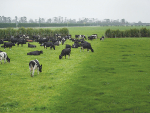I have been a frequent visitor since, speaking and consulting, and have witnessed the continuing growth and development. Since then the Australian wine sector has boomed, then crashed. The New Zealand industry has boomed, then stalled, and is now growing again.
Many Australian producers bemoan the WET tax, but the issues are much greater than this. Here I present my perspectives on what I see and hear on both sides of the Tasman.
Why Compare Australia And New Zealand?
Why, indeed? There is compelling evidence that the New Zealand wine sector is in better health than that of Australia. Figure 1 shows the patterns of export volume and value for both countries, from 1990 to present. In 2007 Australia’s export value began to fall. There was a decline at an average rate of A$148 million per annum from 2007 to 2014, compared with an increase of NZ$79m per annum for the same period. At these rates of change, New Zealand would surpass Australia’s export earnings in 2018 on a dollar for dollar basis. The exchange rate at the time of writing was AUD = 1.04 NZD.
The rate of decline of Australia’s earnings has slowed since 2011 (see Figure 1). Using the last three year’s data only this would indicate that New Zealand exports by value will surpass those of Australia in 2022. It’s not a bad effort for a country with a quarter of the vineyard area of Australia (NZ had 35,500ha in 2014 and growing, Australia had 148,000ha in 2012 and shrinking).
There are other signs as well. A Kiwi wine, Oyster Bay Sauvignon Blanc, is the biggest selling white wine in Australia. The average value of New Zealand wine into the UK is the highest of any country. The US is about to become the largest market for New Zealand wine, and New Zealand Sauvignon Blanc and Pinot Noir are the in-demand varietal wines according to recent reports.
These varieties also represent the top two plantings in New Zealand, so that is encouraging for continued growth.
All That Glitters Is Not Sauvignon Blanc
No doubt New Zealand was lucky with Sauvignon Blanc in Marlborough, developing a reputation as it now has as a classic wine, and maybe the world’s best Sauvignon. It is certainly well known, and very distinctive. Interestingly, on a competitive basis, similar climates occur in Australia, in Tasmania mostly; the widely planted clone in New Zealand is not so widely planted in Australia, which is unfortunate for Australia. I have never understood why.
I believe there are other reasons why New Zealand is outperforming Australia (and other countries), and in this article I want to review them. They are not presented necessarily in order of importance.
New Zealand Wine Sector Is Better Organised
New Zealand has one industry organisation, New Zealand Winegrowers (NZW). Australia had four, but only recently changed to three (AGWA, Winemakers’ Federation of Australia (WFA) and Wine Grape Growers Australia (WGGA)). NZW represents some 850 growers and 700 wine producers; it was formed in 2002 by merging the Grape Growers Council and the Wine Institute. It has roles of advocacy at all levels, providing a global marketing platform, facilitating research, providing strategic information and organising sector wide events such as the annual Romeo Bragato Conference and Air New Zealand wine awards. It is funded by compulsory levies on grape and wine production.
NZW has strong connections with the government, presumably because it is easier to deal with one than many industry bodies. If you want to see what I mean, compare websites and the industry information available on both sides of the Tasman.
Industry solidarity is an important difference between New Zealand and Australia, and surely contributes to the overall performance. New Zealand has wisely opted for an annual industry-wide conference, the Romeo Bragato conference, named after the Italian-born pioneering viticultural scientist of New Zealand. This three- day event rotates around the regions more or less, and offers a program of technical, sustainability, marketing and advocacy issues, with the focus and theme changing yearly. There is a wine competition, a young viticulturist award, a trade exhibition and a conference dinner. Last year there were 540 attendees.
The Australian approach does not, in my opinion, encourage such solidarity across all sectors of the industry. There is the Australian Wine Industry Technical Conference (AWITC) held every three years. It is a large event with more than 1000 attendees, and limited to capital cities. It is organised by the Australian Society of Viticulture and Oenology (ASVO) and the Australian Wine Research Institute (AWRI). The 16th AWITC in 2016 is scheduled over six days from 23-28 July. There are many international speakers, poster presentations, and a conference dinner. All in all, it will be a grand affair, but very expensive to attend.
Once essentially covering viticulture and oenology, conference presentations in marketing and sensory evaluation are now more common, and more recently presentations of limited discussion about industry issues have been included.
There is a lot that can happen in a dynamic, export-orientated wine sector over three years. I wonder if the size, length, expense and especially the frequency of this conference is out of date and inappropriate to current needs.
There is also the biennial Outlook Wine Industry Conference organized by WFA, held over two days and dealing more with industry matters, but from the viewpoint of hosting single industry organization. Then there is the SA Wine Industry Association’s one-day Wine Industry Environment Conference.
New Zealand Wines Are Better, So Says The Consumer, And Some Wine Judges
Of course, this is a generalisation that will cause much angst among (Australian) readers, but the facts remain about the average value of Australian and New Zealand wines in many markets. The reasons are simple: New Zealand wine regions are cooler. For the varieties important in today’s marketplace, wines are acknowledged as being better appreciated when not grown in hot regions. Australia’s inland irrigation regions are euphemistically called ‘warm’, and the rest ‘cool’, but these terms are not appropriate and surely their use should be discouraged.
Mean January Temperature (MJT) is an index used to describe the heat in a viticultural region. The majority of grape production in Australia occurs in temperatures ranging from 19.5-24.5°C (and the majority of production is at the hotter end, around 23°C), while in New Zealand the corresponding figures are 17.5-19.5°C. To put these figures in some perspective, the MJT for Sunraysia is 23.9°C, Griffith 23.8°C, Barossa Valley 21.4°C, Yarra Valley 19.4°C, Adelaide Hills 19.1°C, Hobart 17.7°C, and Launceston 17.2°C. Corresponding values for New Zealand are Hawke’s Bay 18.8°C, Marlborough 17.6°C, and Central Otago 17.1°C. I present data for Tasmania, where I recently lived, as it is an important potential area for vineyard production, but there
are other cool climate regions on the mainland, typically associated with the Great Dividing Range and southern coast, which could also warrant vineyard expansion.
There are historical and social reasons why Australia has planted so many grapes in such hot regions, but the question remains why these hot area plantings expanded so much in the most recent boom. Australia could plant vineyards in cool regions with temperatures like those in New Zealand. For example, I can see that plantings of the present size of those in New Zealand could be accommodated in Tasmania alone. I have done the surveys. The climate, land and water are available. For reasons best known to itself, the Australian wine sector has failed to significantly invest in genuine cool climate regions. It could, and it should, if it wants to be globally competitive, at least in the premium wine sector.
The relative climate position of Australian vineyards becomes worse with anticipated global warming. New Zealand, and Tasmania, are small islands in a large, cold ocean and are predicted to suffer less impact from global warming. Already the impact of heat waves is experienced in Australian vineyards, especially damaging to fruit ripening and leaf health, a situation that is predicted to worsen.
Of course some varieties are adapted to warmer regions, and Shiraz wines of the Barossa Valley and Mclaren Vale have international reputations. Sadly this is being challenged by concepts of improved quality for Shiraz grown in cool climates. The international Three Nations competition, now expanded to Six Nations has often seen Shiraz wines from the Gimblett Gravels of Hawke’s Bay out perform those of Australia.
Another general comment is that Australian vineyard development and wine promotion has emphasized variety, whereas in New Zealand there has been more variety by region development. The latter approach is arguably more relevant to today’s market and to regional promotion.
Sustainable Viticulture
New Zealand has taken an early lead in sustainable viticulture programs, being established in 1994 and commercially adopted in 1997. It is now supported by NZW, which is conspicuous on its website, and is embraced by growers through all regions. The program is seen as a ‘framework for viticultural and winemaking practices that protect the environment while efficiently and economically producing premium winegrapes and wine’. This is seen as being important in today’s wine markets, part of the New Zealand ‘story’ of clean and green. There is a goal of having 100% of grapegrowers and winemakers operating under the approved and independently audited sustainability programs, and there are published standards and auditing procedures.
There is an Organic Winegrowers New Zealand Growers Association, founded in 2007, dedicated to the production of high quality organic wines. This organisation has proclaimed a goal in 2011 of 20% of all of New Zealand’s vineyards being organic. Working with NZW, the organisation developed an Organic Focus Vineyard Project in 2011 to document the impact of changing from conventional to organic production over three seasons and in three regions. The results are freely available and have been the subject of seminars and vineyard visits.
Sustainable wine and grape production is not so well developed in Australia. Entwine Australia was launched in December 2009 by WFA with initial support from the Federal Government. It was developed with wineries and vineyard operators in mind. The program currently has about 735 members spread across all wine-producing regions. Entwine does not set requirements of performance criteria, nor does it provide auditing. It operates in the context of a voluntary use of a process standard.
In April 2012, the McLaren Vale Sustainable Winegrowing Australia program was developed. The program is based on self-assessment, and there is no auditing. It is open to growers throughout Australia. It remains to be seen how popular it becomes, despite its self-proposed excellence. By any measure, New Zealand has taken the high ground on the sustainability issue.
Research
Having a background in viticulture research in both countries gives me a particular interest here. I am aware that research can significantly assist local industries, especially when targeted to local problems.
NZW runs an extensive portfolio of research projects with the aim of ‘Providing and promoting a technological basis for the New Zealand grape and wine industry to remain internationally competitive as the leading producer
of premium quality wines’. NZW contracts research from government research institutes and both Lincoln and Auckland Universities, and some other government funding agencies. NZW co-invests significant levy funds into these programs to create a critical mass of research activity in the grape and wine area.
Major research programs are directed by NZW, co-funded by government, and can involve extended timeframes (up to seven years). One interesting R&D program is into ‘lifestyle wines’, namely high quality but with lower alcohol and calorific content.
A feature of the NZW research program is that it has significant industry input. The program is managed by NZW’s permanent staff, but there is a NZW research committee comprising industry representatives who are currently active in grape and wine production. This provides for a strong industry focus on research activities, and local problem solving has high priority.
An equally strong focus is in the extension of research results. Research progress reports and summaries are carried in the New Zealand Winegrower. Research results are not limited to scientific paper reporting, but deliberately extended for industry use. Researchers have an obligation to write popular articles. The NZW website lists research reports (some of which are available only to members), online tools, archived New Zealand Winegrower articles and excellent fact sheets.
NZW’s research program is particularly active in grapevine diseases threatening the industry. There was a significant problem with the spread of grapevine leafroll virus 3 (LRV3) in the Gimblett Gravels, one of New Zealand’s most important terroirs. Based on local research and international cooperation, and the support of landowners in the area, the NZW program appears effective in overcoming the problem, which is a notable achievement. I know Australian vineyards where LRV3 is spreading and attracting little response. There is currently much emphasis on grapevine trunk diseases, not surprisingly since Sauvignon Blanc is so susceptible.
Grape and wine research administration in Australia is in transition, with the responsibility passing to the recently formed AGWA from the previous Grape and Wine Research and Development Corporation (GWRDC). AGWA is funded by grapegrowers and winemakers through levies and user-pays charges and the Australian government, which provides matching funding for R&D investments. Currently the interim board of AGWA has strong industry representation, but whether this will persist remains to be seen. There is no website information available on industry input to the allocation of research funds. There were certainly complaints about the lack of current industry experience among members in prior GWRDC boards, which were responsible for funding allocations.
Research and extension providers include the Australian Wine Research Institute, the National Wine and Grape Industry Centre, CSIRO, universities and state agencies. Regional programs are a key initiative of AGWA that seek to actively encourage and support innovation, extension and adoption across wine regions. AGWA has a stated strong commitment to innovation and adoption principles.
The AGWA website lists previous research reports, as well as fact sheets. The fact sheets were not as comprehensive as those for New Zealand, nor as up to date, but this may reflect the organisation being in transition.
In any event, I would conclude that research to support the grape and wine industry is more relevant and better managed in New Zealand, with more industry input. This opinion is subjective, and the Australian effort may be disadvantaged by the recent change of governance. Only time will tell if the game will be lifted.
Conclusion
From the attributes considered here, New Zealand could be considered to be outperforming Australia, which I believe is contributing to the better export effort. There are other issues that could be considered, like why New Zealand has not gone down the geographical indication route for regional definition, as Australia has done. That could be interesting. Has the plethora of small GIs helped Australia’s export effort? I doubt it.
I had a fear while writing this article that some may be inclined to shoot the messenger.
After all, I could be seen as critical of many organisations in the Australian wine sector.
Most have been mentioned in this article. Be that as it may, I would hope that my opinion and observations may lead to opportunities to improve the lot of the Australian wine sector, which was the intention.
I do not want to suggest that all is rosy in New Zealand. I hear grumbles about NZ Winegrowers being too powerful, and about the costs and efficiency of the sustainable winegrowing program. There are sure to be other problems that I do not hear about.
Furthermore, I do not want to appear to be overly critical of the Australian wine sector’s achievements. I do care that this wonderful industry might again regain economic stability for all of its stakeholders, and begin to reverse its fortunes. Don’t abuse me because I care.
- This article was first published in Wine & Viticulture Journal, Australia and is reprinted here with their permission.














